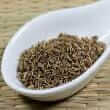Background
- Anise, a native to the eastern Mediterranean, is one of the oldest known spice plants. It is used for both medicinal purposes and for food. It is a member of the Apiaceae family, which includes carrot, parsley, dill, fennel, coriander, cumin, and caraway.
- The Greek name anison and the Latin name anisum were derived from the early Arabic name anysum. Evidence suggests that anise was used in Egypt as early as 1500 B.C. The Romans used anise-spiced cakes to aid digestion after heavy meals. The oil of anise, which has a strong licorice flavor, is mixed with wine to form the liqueur anisette. Oil of anise also found in raki, a Turkish alcoholic beverage, and ouzo, a Greek alcoholic beverage.
- Anise is used as a spice in cooking. Medicinally it is used to promote digestion and to increase urine flow. Anise oil is used in flavoring artificial licorice candies, cough lozenges, and syrups.
- Anise is used in Europe to aid cancer treatment. In Mexico, Turkey, and China, it is used as a carminative (relieves intestinal gas) and galactagogue (stimulates breast milk production). Elsewhere, it is used to induce abortion and to treat respiratory illnesses, such as asthma, bronchitis, and cough. In combination with other herbs, anise has been used to treat head lice infestation. Anise is recognized by the U.S. Food and Drug Administration (FDA) as Generally Recognized as Safe (GRAS).
References
Natural Standard developed the above evidence-based information based on a thorough systematic review of the available scientific articles. For comprehensive information about alternative and complementary therapies on the professional level, go to . Selected references are listed below.
- Adimoelja A. Phytochemicals and the breakthrough of traditional herbs in the management of sexual dysfunctions. Int J Androl 2000;23 Suppl 2:82-84.
View Abstract - Al Bayati FA. Synergistic antibacterial activity between Thymus vulgaris and Pimpinella anisum essential oils and methanol extracts. J Ethnopharmacol 2008;116(3):403-406.
View Abstract - Al Mofleh IA, Alhaider AA, Mossa JS, et al. Aqueous suspension of anise "Pimpinella anisum" protects rats against chemically induced gastric ulcers. World J Gastroenterol 2007;13(7):1112-1118.
View Abstract - Amin KA, Nagy MA. Effect of Carnitine and herbal mixture extract on obesity induced by high fat diet in rats. Diabetol Metab Syndr 2009;1(1):17.
View Abstract - Bluma R, Amaiden MR, Daghero J, et al. Control of Aspergillus section Flavi growth and aflatoxin accumulation by plant essential oils. J Appl Microbiol 2008;105(1):203-214.
View Abstract - Buechi S, Vogelin R, von Eiff MM, et al. Open trial to assess aspects of safety and efficacy of a combined herbal cough syrup with ivy and thyme. Forsch Komplementarmed Klass Naturheilkd 2005;12(6):328-332.
View Abstract - Chaudhry NM, Tariq P. Bactericidal activity of black pepper, bay leaf, aniseed and coriander against oral isolates. Pak J Pharm Sci 2006;19(3):214-218.
View Abstract - Haggag EG, Abou-Moustafa MA, Boucher W, et al. The effect of a herbal water-extract on histamine release from mast cells and on allergic asthma. J Herb Pharmacother 2003;3(4):41-54.
View Abstract - Ize-Ludlow D, Ragone S, Bruck IS, et al. Neurotoxicities in infants seen with the consumption of star anise tea. Pediatrics 2004;114(5):e653-e656.
View Abstract - Janahmadi M, Farajnia S, Vatanparast J, et al. The fruit essential oil of Pimpinella anisum L. (Umblliferae) induces neuronal hyperexcitability in snail partly through attenuation of after-hyperpolarization. J Ethnopharmacol 2008;120(3):360-365.
View Abstract - Nahid K, Fariborz M, Ataolah G, et al. The effect of an Iranian herbal drug on primary dysmenorrhea: a clinical controlled trial. J Midwifery Womens Health 2009;54(5):401-404.
View Abstract - Robertshawe P. Antibacterial Activity Of Some Plant Essential Oils. Journal of the Australian Traditional-Medicine Society 2007;13(3):165.
- Singh G, Kapoor IP, Pandey SK, et al. Studies on essential oils: part 10; antibacterial activity of volatile oils of some spices. Phytother Res 2002;16(7):680-682.
View Abstract - Tominaga H, Kobayashi Y, Goto T. DPPH radical-scavenging effect of several phenylpropanoid compounds and their glycoside derivatives. Yakugaku Zasshi 2005;125(4):371-375.
View Abstract - Yoney A, Prieto JM, Lardos A, et al. Ethnopharmacy of Turkish-speaking Cypriots in Greater London. Phytother Res 2010;24(5):731-740.
View Abstract







